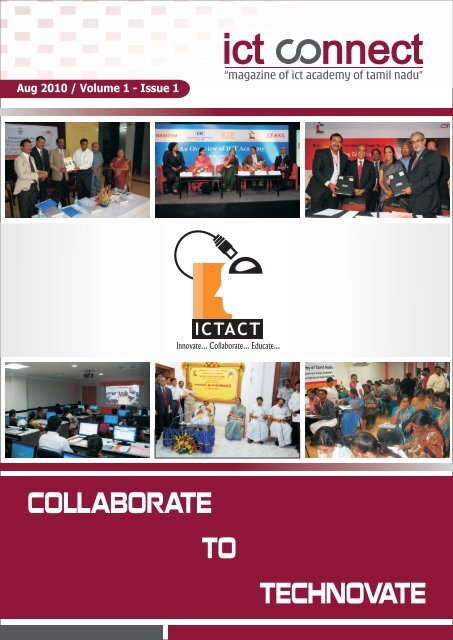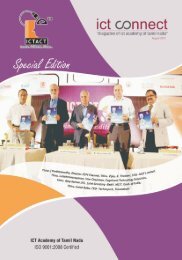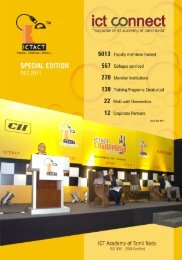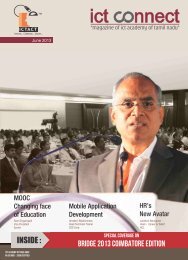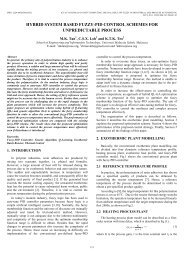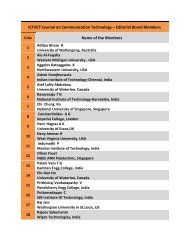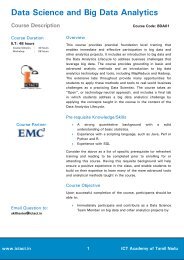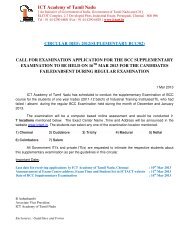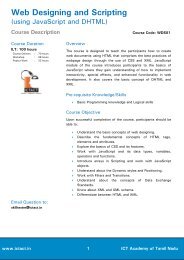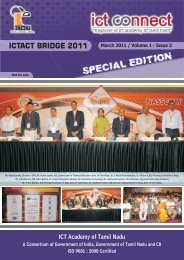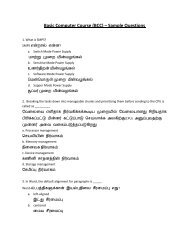Issue 1 - ICTACT.IN
Issue 1 - ICTACT.IN
Issue 1 - ICTACT.IN
Create successful ePaper yourself
Turn your PDF publications into a flip-book with our unique Google optimized e-Paper software.
Aug 2010 / Volume 1 - <strong>Issue</strong> 1<br />
COLLABORATE<br />
TO<br />
TECHNOVATE
magazine<br />
C O N T E N T<br />
Aug 2010<br />
2<br />
About ICT Academy<br />
of Tamil Nadu<br />
2010 – 2020 - A Decade<br />
of Innovations<br />
5<br />
6<br />
Writing High Performance<br />
.NET Code<br />
IT for Non IT Teachers - A Joint<br />
Initiative of University of Madras<br />
and ICT Academy of Tamil Nadu<br />
9<br />
10<br />
Language & Communication Skills<br />
Launch of <strong>ICTACT</strong> Educational<br />
Portal & Release of <strong>ICTACT</strong> Journal<br />
on Communication Technology<br />
11<br />
12<br />
Employability-an Industry<br />
Perspective<br />
<strong>ICTACT</strong> - ORACLE Higher Education<br />
Initiative For Tamil Nadu<br />
14<br />
16<br />
The Value of Certification<br />
for IT Professionals<br />
CII – NASSCOM – <strong>ICTACT</strong> Event on<br />
“Role of ICT Academy for<br />
the Industry”<br />
19<br />
22<br />
Eventz<br />
Creative Industry is India’s Future<br />
23<br />
ICTConnect<br />
A Quarterly Magazine from ICT Academy of Tamil Nadu<br />
Volume I - <strong>Issue</strong> 1 - Aug 2010<br />
Editorial Board<br />
Dr. J.G. Sheshasaayee<br />
Dr. G. Sainarayanan<br />
Mr. B. Anbuthambi<br />
Dr. K. Narasimhan<br />
Published By<br />
ICT Academy of Tamil Nadu<br />
ELCOT Complex, 2-7 Developed Plots<br />
Industrial Estate, Perungudi, Chennai - 600 096<br />
Ph : 91- 044 42906800<br />
Fax : 91- 044 42906820<br />
E-mail : ictconnect@ictact.in<br />
Website : www.ictact.in<br />
Disclaimer : The text and other material on ICTConnect magazine are the views and opinions of the specific author and are not statements of advice, opinions, or<br />
information of ICTConnect or ICT Academy of Tamil Nadu. All trademarks and/or registered trademarks are the property of their respective companies and /<br />
or owners. Nothing may be reprinted in whole or in part without written permission from the publisher. Individuals are authorized to<br />
photocopy items only for personal use and not for commercial use.<br />
Published by ICT Academy of Tamil Nadu by its Editorial Board and Printed at Knack Media Solution, Chennai - 26. Website : www.knackmedia.in<br />
ICT CONNECT MAGAZ<strong>IN</strong>E<br />
1
magazine<br />
About ICT Academy of Tamil Nadu<br />
ICT Academy of Tamil Nadu (<strong>ICTACT</strong>) is a<br />
not for profit autonomous society, formed as a<br />
Consortium of Government of India, Government of<br />
Tamil Nadu and Confederation of Indian Industry<br />
(CII) under the Private – Public - Partnership (PPP)<br />
model that endeavors to create an industry relevant<br />
knowledge eco system and the next level of talent pool.<br />
In the current scenario, the issue faced by both<br />
industry and institutions is addressing the gap between<br />
University curriculum and industry requirements.<br />
The need was felt by the Industry, Government and<br />
Academia to create a platform to address this critical<br />
issue. This would enable to make Tamil Nadu an ICT<br />
hub.<br />
<strong>ICTACT</strong> has associated with the leading<br />
Universities and Academic institutions to understand<br />
and cater to their requirements. Over 450 institutions<br />
are now being serviced by the academy.<br />
<strong>ICTACT</strong> has associated with Corporate bodies<br />
like Cognizant Technology Solutions, Tata<br />
Consultancy Services, Microsoft Corporation, Intel,<br />
Hexaware Technologies, Oracle, National<br />
Instruments, Cadence etc, to support this novel<br />
initiative. Through this initiative, the Industry shall<br />
benefit by the improved availability of quality talent<br />
pool that is industry ready. This will help the industry<br />
to cut down on training costs and reduce the lead time<br />
required to deploy fresh talent in to productive work.<br />
The need is also felt to have industry – institute<br />
interaction to share the ever changing industry<br />
requirements in terms of technology and the skills<br />
required for the future talent pool.<br />
<strong>ICTACT</strong> is a platform for all the stakeholders of<br />
the knowledge ecosystem to Innovate, Collaborate<br />
and Educate.<br />
2<br />
<strong>ICTACT</strong> publishes peer-reviewed international<br />
journals every quarter. Currently <strong>ICTACT</strong> publishes<br />
the following three journals.<br />
<strong>ICTACT</strong> Journal on Communication<br />
Technology (IJCT)<br />
<strong>ICTACT</strong> Journal on Soft Computing (IJSC)<br />
<strong>ICTACT</strong> Journal on Image and Video<br />
Processing (IJIVP)<br />
Governing Board<br />
Mr. Lakshmi Narayanan<br />
Vice Chairman<br />
Cognizant Technology Solutions<br />
Mr. P.W.C. Davidar IAS<br />
IT Secretary<br />
Government of Tamil Nadu<br />
Dr. Santhosh Babu IAS<br />
Director & CEO<br />
Tamil Nadu e-Governance Agency<br />
Mr. K. Jayaramakrishnan<br />
Vice President<br />
Tata Consultancy Services<br />
Mr. Som Mittal<br />
President<br />
NASSCOM<br />
Mr. Gopal Srinivasan<br />
CMD<br />
TVS Capital Funds Ltd<br />
Mr. M. Raghunandan<br />
Director<br />
Redington India<br />
Mr. Sameer Garde<br />
Country Head<br />
Dell India<br />
R. Nandini<br />
Chairperson<br />
CII TN State Council<br />
Mr. M. Sivakumar<br />
CEO<br />
ICT Academy of Tamil Nadu<br />
ICT CONNECT MAGAZ<strong>IN</strong>E
magazine<br />
M E S S A G E<br />
K Jayaramakrishnan<br />
Vice President – Global Alliances,<br />
Tata Consultancy Services<br />
Member of the Governing Board,<br />
ICT Academy of Tamil Nadu<br />
It gives me immense pleasure to share my thoughts for “ICT Connect” – a magazine from the house of ICT<br />
Academy of Tamil Nadu. The scenario around the globe is changing and the demand for quality manpower is<br />
increasing. I am glad to inform you that <strong>ICTACT</strong> works towards the key objective of empowering the academia<br />
and the industry through its bridging the industry – academia gap thereby creating the new generation of industry<br />
relevant talent pool.<br />
<strong>ICTACT</strong> over the last one year has been associated with hundreds of colleges and all state Universities in<br />
Tamil Nadu. The interest and enthusiasm shown by the higher education community has been great and found to<br />
be increasing.<br />
Corporate bodies such as Tata Consultancy Services, Cognizant, Microsoft, Intel, Oracle etc. have come<br />
forward to support <strong>ICTACT</strong> in the PPP model. I take this opportunity to invite corporate in the IT, ITES,<br />
Electronics and Telecom verticals to participate in <strong>ICTACT</strong> and support us to create the industry relevant<br />
manpower for our industry, specifically in Tamil Nadu.<br />
ICTConnect magazine is the outcome of our understanding from the academia and the industry on the need<br />
to share the best practices and success stories in both sides.<br />
The key aim of this magazine is to provide a platform for the corporate executives, teachers, students,<br />
researchers and domain experts to share and learn technological advances in ICT, Best practices of the industry,<br />
Career guidance for students, Skill development initiatives, Industry relevant Case studies, teaching and learning<br />
methodologies, emerging areas in ICT, Industry expectations, Skill Gap Analysis and more. I am sure this<br />
magazine would help all stake holders of the education eco system including the industry and academia.<br />
With best wishes<br />
K. Jayaramakrishnan<br />
ICT CONNECT MAGAZ<strong>IN</strong>E<br />
3
magazine<br />
M E S S A G E<br />
R. Nandini<br />
Chairperson – CII TN State Council &<br />
Secretary, GRG Institutions<br />
I am very happy to note that <strong>ICTACT</strong> is bringing out a new magazine “ICT Connect” as a platform for<br />
students, researchers, teachers and working executives to share knowledge and experiences related to the latest<br />
trends in ICT.<br />
Since its inception, <strong>ICTACT</strong> has been rendering very high quality service to its stakeholders. Among its<br />
many activities and programmes, it has focused on a critical need of educational institutions – faculty<br />
development. As we all know, there is an acute shortage of qualified and experienced faculty in many of the<br />
institutions today. And, there is an undeniable reality of lack of readily-employable students for the industry. This<br />
is an area that requires concerted efforts from all of us who are engaged in generating young, technology-enabled<br />
leaders for tomorrow. Realisation of our dream for India 2020 depends on how technologically advanced we are.<br />
It is in this context that the effort of <strong>ICTACT</strong> in bringing out ‘ICT Connect’ needs to be seen and<br />
commended.<br />
I wish <strong>ICTACT</strong> all the success it deserves.<br />
With best wishes<br />
R. Nandini<br />
4<br />
ICT CONNECT MAGAZ<strong>IN</strong>E
magazine<br />
2010 – 2020 - A Decade of Innovations<br />
Dr. J.G. Sheshasaayee, President<br />
ICT Academy of Tamil Nadu<br />
Our Prime Minister Dr. Manmohan Singh has<br />
declared 2010 –2020 as a “Decade of Innovations” during<br />
his inaugural address in the 97th session of Indian<br />
Science Congress held on 3rd January 2010 at<br />
Thiruvananthapuram. The primary objective of this<br />
declaration is to develop an innovation- based ecosystem,<br />
which aims at producing solutions for the<br />
societal needs in terms of healthcare, energy, urban<br />
infrastructure, water and transportation.<br />
The Ministry of Science & Technology in its 11th<br />
five year plan (2007-12) has made a plan outlay of 75,304<br />
crores for promoting scientific and technological<br />
advancements through research agencies and academia.<br />
There are many areas which need innovation, especially<br />
the agriculture sector for tracking monsoons, prediction<br />
of natural disasters, guiding farmers with environment<br />
changes, smart-water usage etc. and also in the areas of<br />
personalized medicine which directly involves genebased<br />
products and services, biomarkers, development<br />
of pharmaceuticals for gene-based diseases, replacing<br />
surgeries and chemotherapy in the field of healthcare,<br />
advanced manufacturing, nano technology, pervasive<br />
computing, Bio-fuels, Water management, carbon<br />
management, advanced transportation, energy<br />
management, security and tracking.<br />
Technology and Innovation are two critical<br />
factors for inclusive growth; hence collaboration<br />
between academia, corporate and research institutions<br />
become vital. This collaboration will be of mutual<br />
benefit and hence would result in a win-win situation,<br />
ultimately benefitting the society and increasing the<br />
economic strength of the country.<br />
According to the draft version of “The National<br />
Innovation Act of 2008” the Government of India would<br />
Promote finance for innovation and setting up of special<br />
innovation zones for establishment of clustering<br />
enterprises engaged in scientific, mathematical,<br />
technological or engineering research or services, for the<br />
purpose of innovation. There are also measures from<br />
ICT CONNECT MAGAZ<strong>IN</strong>E<br />
appropriate government to support Public-Private<br />
initiatives which facilitate and encourage innovation,<br />
including in low cost technologies, products and services<br />
for the benefit of common man whether in rural or in<br />
urban India.<br />
The corporate bodies like Biocon, Dr. Reddy’s<br />
Laboratories, Ranbaxy Laboratories, Cadila Healthcare,<br />
SmithKline specializing on low cost medicine and<br />
affordable health care, TATA’s, Mahindra in<br />
automobile segment, Aricent, HCL, TATA in the<br />
telecommunication domain, TCS, Infosys, HCL in IT<br />
sector and many more. In addition to India based R&D<br />
companies, around 150 MNCs already have a presence in<br />
Indian R&D industry. To list a few, Microsoft, SAP, Dell<br />
and AMD in IT arena, Daimler-Chrysler in the<br />
automobile sector, LG, Nokia, Motorola and others in<br />
the Telecommunication domain, Rolls-Royce in aerospace<br />
sector etc. These corporate have their own research<br />
centers and collaborate with their research wing for<br />
providing solutions favoring mankind.<br />
At this point of time, it is imperative that the<br />
corporate sponsored research departments, research<br />
agencies like DST, CSIR, DRDO, ICMR, ISRO etc and<br />
academia need to collaborate and innovate newer<br />
products, newer applications and newer technology<br />
which would help India to emerge vastly as a global leader<br />
by 2020.<br />
Dr. JG Sheshasaayee, President, ICT Academy of<br />
Tamil Nadu, is a Ph.D holder in Computer Applications and<br />
Engineering Education. He has over 25 years of experience in<br />
Software Development, Academia and Education Industry.<br />
He has authored 18 books in the field of computer science and<br />
authored over 45 research articles. He is currently responsible<br />
for Business process management at <strong>ICTACT</strong>. His research<br />
interests are e-Learning, User Interface and Educational<br />
Technology.<br />
5
magazine<br />
Writing High Performance .NET Code<br />
Milind P Hanchinmani, Sr. Application Engineer, Intel<br />
Introduction<br />
Since most day to day operations are moving<br />
online (Core banking, Reservations, Shopping),<br />
software performance has become vital to their success.<br />
So many a times visits to a web site takes long time to<br />
load, resulting in frustration and the migration to a<br />
different site (similar business). For businesses this can be<br />
fatal as they lose customers. Web sites often slow or even<br />
go down when traffic increases. Performance/stress<br />
testing of your application can help avoid such<br />
downtime. There are tools that tell you performance of<br />
your application is bad but not necessarily why. But if<br />
you have information knowing what to look for, what is<br />
good and what is bad, will put your application in better<br />
shape later.<br />
With Microsoft® .NET Framework, developers<br />
can now build complete business solutions quickly with<br />
more functionality and robustness with its rich and easy<br />
to use features and functionality. But with this comes<br />
increased opportunity for architects and developers to<br />
design and build poor, non scalable solutions because<br />
architecting and designing these solutions are not really<br />
very straight forward. This paper talks about the core<br />
performance related issues that one should be aware of in<br />
.NET. It also focuses on some common mistakes which<br />
one should avoid and provider few tips for writing high<br />
performance .NET code.<br />
This paper will discuss:<br />
.NET Framework components and CLR<br />
execution Model<br />
Threading support in .NET and tips for avoiding<br />
common threading mistakes<br />
Automatic Memory management – Writing GC<br />
friendly code<br />
Briefly talks about performance tools available<br />
for tuning .NET code<br />
.NET Framework Components and CLR execution Model<br />
Languages (C#, VB.NET, C#)<br />
Presentation Layers (Windows Forms / Web Forms)<br />
Base Class Libraries (String, ADO.NET, XML)<br />
Common Language Runtime<br />
(GC, Threading, Object Manager, Security)<br />
Windows Operating Systems<br />
The .NET Framework provides a run-time<br />
environment called the CLR, which manages the<br />
execution of code and provides services that make the<br />
development process easier. CLR provides features such<br />
as automatic memory management (GC), exception<br />
handing, security, type safety, JIT (Just in time compiler<br />
for converting msil to native code) and more. CLR is<br />
implemented as a dll called “mscorwks.dll”. It also has<br />
support for Base Class Libraries (BCL) which sits on top<br />
of CLR, providing libraries for functionalities such as<br />
String, File I/O, and Networking, Collection classes,<br />
Data Access (ADO.NET) and XML processing. On top<br />
of BCL there are presentation layers (Web Forms and<br />
Windows forms), which provide UI functionality. Last,<br />
one finds the languages that Microsoft ® provides for<br />
.NET. Currently there are more than 15 different<br />
languages that are targeted for .NET framework.<br />
CLR Execution Model:<br />
6<br />
ICT CONNECT MAGAZ<strong>IN</strong>E
magazine<br />
Each Language has a compiler which compiles and<br />
converts the code to msil (Microsoft® Intermediate<br />
Language). There are multiple optimizations that are<br />
built into each of these compilers which produce<br />
efficient IL code. Then CLR takes over and it has the JIT<br />
compiler convert this IL code into native code that CLR<br />
can execute. The JIT compiler also has many<br />
optimizations built in which can produce efficient native<br />
code for better performance. If the code is unmanaged,<br />
then we bypass most of this and can directly run<br />
unmanaged programs. Note that .NET provides<br />
additional features by which we can use pointers to<br />
access arrays etc through a feature called “unsafe” for<br />
better performance.<br />
Threading support in .NET and tips for avoiding<br />
common threading mistakes:<br />
Threading support in .NET is implemented in<br />
System.Threading namespace. This provides the classes<br />
and functions such as creating/destroying threads,<br />
synchronization primitives for atomic access that<br />
needed to write multi threaded code. This namespace<br />
also provides a class that allows us to use the pool of<br />
system provided threads called “Threadpool”.<br />
Threadpool basically handles thread creation and<br />
cleanup. It recycles threads to minimize the thread<br />
creation and clean up overhead. Threadpool also sees<br />
other threads running such as GC threads so it can adjust<br />
the thread creation logic. A developer may not consider<br />
the number of threads that should be used, critical to<br />
proper performance. Threadpool also has built in<br />
heuristics enabling it to adjust the number of threads. It<br />
is recommended to use thread pool when you are<br />
thinking about threading your application. ASP.NET<br />
already uses Threadpool for processing web requests.<br />
Earlier, in this article it is mentioned that<br />
Threadpool automatically decides how many threads are<br />
needed for optimal performance. For ASP.NET (web)<br />
applications, tune using the machine.config file to<br />
reduce the contention. Tune using this method when the<br />
following conditions are true (2)<br />
You have available CPU<br />
Your application performs I/O bound operations<br />
and<br />
The ASP.NET Applications\Requests in<br />
Application Queue performance counter indicates that<br />
requests are getting queued.<br />
<br />
<br />
Requests will be queued if total # of available threads falls below this number.<br />
minLocalRequestFreeThreads="32" -> Requests from the local host will be queued if total # of available<br />
threads falls below this number.<br />
/><br />
maximum # of worker threads in a threadpool. This is per CPU.<br />
maxIoThreads="12" -> maximum number of I/O threads in a threadpool. This is per CPU.<br />
minWorkerThreads="40" -> minimum worker threads available in the system @ any time. This is for the<br />
entire system<br />
/><br />
Note: These values are not recommended values but just used for illustration purposes.<br />
7<br />
ICT CONNECT MAGAZ<strong>IN</strong>E
magazine<br />
So, how does the formula work<br />
T h e n u m b e r o f w o r k e r t h r e a d s =<br />
maxWorkerThreads*# of CPU (Cores) in the system –<br />
minFreeThreads 16 = 12*4-32 (assuming you are<br />
running a 4 core machine). The total number of<br />
concurrent requests you can process is 16. But an<br />
interesting question arises. How do you know that this<br />
actually worked Look at the “Pipeline Instance Count”<br />
performance counter and it should be equal to 16. Only 1<br />
worker thread can run in a pipeline instance count so<br />
you should see a value of 16. You have to be very careful<br />
when doing this as performance may degrade if you use<br />
random values.<br />
.NET threading API’s and Thread pool make a<br />
developer’s life easier, but still there are many threading<br />
related issues that can hurt performance and scalability.<br />
Creating more or fewer number of threads than required<br />
can impact performance. Use Thread pool to help you in<br />
this instance. Ideally, the number of threads will equal<br />
the number of cores, and will yield the highest<br />
performance as each thread that can run concurrently on<br />
a processor. Threading wrong portion of application:<br />
This is by far the major problem in threading. Analyze<br />
your application completely before deciding where to<br />
thread. You have to thread the portion of your code<br />
where you spend most time to get significant<br />
performance. Multi threading also complicates<br />
debugging and events such as dead locks and race<br />
conditions. Have a good debug log (that you can enable<br />
in debug mode) to solve some of these complex nature<br />
bugs.<br />
Threading Tips:<br />
a) Distribute the work equally among threads – If<br />
the work is imbalanced, one thread will finish the work<br />
quickly, but must wait till other thread(s) finish their<br />
job, impacting performance.<br />
b) Don’t use too much shared data among threads<br />
– If any data or data structure is shared among threads,<br />
then synchronization is required to update that data. This<br />
increases the amount of serial code/paths in your<br />
application hurting your scalability<br />
c) Acquire Lock late and release it early. This is very<br />
important as you must take a lock just before you<br />
8<br />
absolutely have to and release it first before doing anything<br />
once the atomic region is executed. Here is an example in<br />
.NET<br />
void foo ()<br />
{<br />
int a, b;<br />
…. //some code<br />
//Following code has to be atomically executed<br />
{<br />
}<br />
…. //Some other code<br />
//End of atomic region<br />
}<br />
//WRONG: Increased atomic region. Lock will be held<br />
longer thus hurting performance<br />
void foo ()<br />
{<br />
int a, b;<br />
Object obj ; //for synchronizati Monitor.Enter(); or<br />
lock(obj) {<br />
…. //some other code<br />
Monitor.Exit(); or }<br />
//End of atomic region<br />
}<br />
//WRONG: Entire function is synchronized. Bad idea.<br />
using System.Runtime.CompilerServices;<br />
MethodImplAttribute(MethodImplOptions.Synchroniz<br />
ed)]<br />
void foo ()<br />
{<br />
int a, b;<br />
…. //some code<br />
//Following code has to be atomically executed<br />
{<br />
}<br />
…. //Some other code<br />
//End of atomic region<br />
}<br />
Milind P Hachinmani, is currently a Senior Application<br />
Engineer with 13 years of industry experience with over 7+<br />
years @ Intel. He joined APAC enabling team last year and<br />
has been working with Enterprise ISV’s and SI’s to improve<br />
their application performance on Intel® Architecture. At<br />
Intel, in his previous role for 6 years Milind worked as a<br />
member of the Intel on-site team at Microsoft in driving<br />
improvements in the quality and performance of three<br />
generations of Microsoft® .NET Framework for Intel<br />
Architecture. His expertise includes performance<br />
methodologies, benchmarking and .NET CLR internals.<br />
To be Continued in the next Edition<br />
ICT CONNECT MAGAZ<strong>IN</strong>E
magazine<br />
IT For NON IT Teachers –<br />
A joint initiative of University of Madras and ICT Academy of Tamil Nadu<br />
Making University of Madras with 100% e’Literate Faculty Members<br />
A study among 500 teachers in Tamil Nadu<br />
across various disciplines showed that 61.25 per cent<br />
favored using ICT in teaching. Even among those<br />
who were in favor of using the ICT, it was necessary<br />
to study the extent of their awareness. Some of the<br />
teachers were only using it for mailing and not for<br />
teaching. There is a strong growing need to shift<br />
from traditional teaching tools to new ones –<br />
primarily those that involve the use of technology.<br />
Urging teachers to become e-literate, Dr. G.<br />
Thiruvasagam the Vice Chancellor of University of<br />
Madras insisted that “the use of information<br />
communication technology could reduce cost and<br />
time and improve the productivity of teachers”. All<br />
communication from University of Madras to any<br />
college from to be made will be paperless, Vice-<br />
Chancellor has said.<br />
This was set to change as the University of<br />
Madras, in association with the ICT Academy of<br />
Tamil Nadu, offered a specific course on “IT for Non<br />
IT Teachers” to train all the Non IT teachers in the<br />
university and its affiliated colleges to make them e-<br />
literate.<br />
<strong>ICTACT</strong> involved in the Design,<br />
Development and Delivery of “IT for Non-IT<br />
Teachers” training program which aimed towards<br />
creating 100% IT literacy among the Non-IT<br />
Teachers of the University of Madras and its<br />
affiliated colleges.<br />
Thiru.K.Ganesan, Principal Secretary - Higher Education, Government of Tamil Nadu<br />
releasing <strong>ICTACT</strong> Newsletter and first copy received by Dr.G.Thiruvasagam,<br />
Vice Chancellor of University of Madras<br />
in their teaching process. The participation in this program<br />
encouraged use of technology in education. Technology<br />
tools can support and enrich the learning process by<br />
putting the students in centre of their quest for knowledge.<br />
This learning process can only happen with the sustained<br />
guidance and thoughtful intervention of the teachers. The<br />
teachers can become the mentor and guide, showing<br />
students how technology can enhance learning. This<br />
curriculum is designed to motivate the teachers get started<br />
with technology.<br />
In the first phase, 760 teachers of University of Madras and<br />
its affiliated Colleges were trained. This course was cosponsored<br />
by Emerge Learning Services and the first batch<br />
launch was held at Bharathi Women’s College, Chennai.<br />
Thiru.K.Ganesan IAS, Principal Secretary to Government<br />
of Tamil Nadu, Higher Education Department, was the<br />
Chief Guest of the Valedictory function conducted at<br />
Bharathi Women’s College and issued the certificates for<br />
the teachers trained in the first batch.<br />
The goal of this program is to enable teachers<br />
use ICT technology tools to enhance teaching –<br />
learning process. This program will not only<br />
empower the teachers with basic IT skills, but also<br />
provide strategies and techniques to use technology<br />
ICT CONNECT MAGAZ<strong>IN</strong>E<br />
9
Language & Communication Skills<br />
Nikhil Indrasenan<br />
Business Head – Ma Foi Academy<br />
Why is it difficult to talk with some people and so<br />
easy to talk with others Is communication a skill or an<br />
art Whatever be the type, communication is a<br />
competency every professional has no choice but to<br />
master. To be a good communicator, do we need to have<br />
sound social skills or will language proficiency suffice<br />
Well, both are important.<br />
The four aspects of communication: reading,<br />
listening, speaking and writing are equally essential and<br />
important. In addition to these four dimensions of<br />
language, body language is also a vital aspect. Conversely<br />
body language is known as nonverbal communication.<br />
Almost all job interviews are based on communication<br />
and language competencies. A good presenter can make<br />
an impression, a very positive one at that, even if he/she<br />
does not demonstrate relevant domain knowledge. I have<br />
heard employers state that role-based skills can be<br />
developed but not language skills.<br />
`Give me a candidate who can articulate well and<br />
write with clarity; we can train him in work skills’. With<br />
communication getting briefer and quicker in this age of<br />
speed, written communication, being the most popular<br />
mode of business interaction, needs to be faultless.<br />
Written English requires more care than spoken English.<br />
Usage of simple and plain words instead of fancy phrases,<br />
and short and concise sentences is a pre-requisite of the<br />
global communication work culture. Brevity does not<br />
imply brusqueness or abruptness. On the one hand, we<br />
have to dispense with redundancy in words – we do not<br />
say `endeavour to ascertain and accomplish’; we just say<br />
`try to find out and complete’. Jargon, trendy<br />
buzzwords, sms-ese, acronyms are all, if featured in<br />
written communication, read with impatience and<br />
irritation! Mark Twain said, `I never use a word like<br />
communication needs to be effective and impacting<br />
getting the expected response to achieve results. Spoken<br />
language is critical too, as it involves self confidence, non<br />
verbal skills, active listening, expression and a good<br />
vocabulary. More important, spoken communication<br />
warrants earnestness, without which, the speaker can<br />
sound shallow and pretentious. Spoken language is a habit<br />
and needs to be cultivated consciously. If picked up and<br />
practiced the wrong way, correction and unlearning takes<br />
10<br />
magazine<br />
a long time. The reason why people think they can get<br />
away with improper and incomplete verbal<br />
communication is because the in-person interaction has<br />
other aspects like body signs, expression, gestures,<br />
interruptions, prompting from listener, and so on. While<br />
all these are important for communication, the verbal<br />
skills remain the primary focus. Many errors and gaps<br />
occur in verbal communication. Verbal or speech tics are<br />
those words which are habitually used by the speaker. Do<br />
you recall your student days, when you noted down the<br />
number of times your teacher uttered – you know, do you<br />
understand, okay<br />
Most of us are not aware of our speech tics and we<br />
regularly use them to start a conversation, fill in the gap<br />
and at times, as mere expressions. One of my colleagues<br />
asked another colleague - so, basically, how are you doing<br />
My other colleague replied - thank you, I am naturally<br />
doing well; but, fundamentally you should not be asking<br />
me this, because you see me every day! Verbal tics can<br />
cause not only annoyance but also fatigue to the listener.<br />
The best way to get rid of this habit is to choose someone<br />
who interacts with you closely and have that person give<br />
you instant feedback. Like I said, unlearning or breaking a<br />
long standing habit takes a while, but in due course of time,<br />
with conscious effort, you will have achieved the desired<br />
results. There are other conversational irritants such as the<br />
hemming and hawing; in other words, hesitation and<br />
fumbling in speech. The new age of speed and quickness<br />
has no room for classic meeting addresses such as this: er…<br />
I attended, hmmm, a meeting with the VP, yes, the VP.<br />
Okay And, and I thought hummm I should share what,<br />
uhh what we discussed, so that………. The group members<br />
by that time would have exchanged a few phone messages,<br />
maybe made couple of quick calls and sent out some<br />
emails. And, can we blame them Clarity, articulation,<br />
pace, choice of vocabulary, assertiveness and confidence<br />
are the components that make verbal communication<br />
highly effective and impactful.<br />
A good communicator is a preferred business leader.<br />
Nikhil Indrasenan possesses over 18 yrs of<br />
entrepreneurial and HR experience in recruitment,<br />
consulting & training. He has managed and delivered on<br />
assignments across multiple industries / locations and found<br />
career opportunities for over 5,000 professionals in his tenure.<br />
He currently holds a dual responsibility of Head - Ma Foi<br />
Randstad Academy and Country Manager and Director of<br />
Ma Foi Randstad Sri Lanka.<br />
ICT CONNECT MAGAZ<strong>IN</strong>E
magazine<br />
Launch of <strong>ICTACT</strong> Educational Portal & Release of <strong>ICTACT</strong> Journal on<br />
Communication Technology<br />
To strengthen the training process, ICT<br />
Academy of Tamil Nadu launched the Educational<br />
Portal to benefit the learners. In the Education Portal,<br />
the teachers have the technology and industryrelevant<br />
content available to them along with the<br />
pedagogical tools for effectively training their<br />
students. Further, the teachers can also benefit from<br />
Simulations, Question Bank etc. which is a part of this<br />
portal. This technology driven learning is a first of its<br />
kind in India. This portal provides equal opportunity<br />
for teachers to have access to industry-relevant<br />
content. The teachers in the second and third tier<br />
towns do not have access to knowledge about<br />
industry requirements and relevant content or the<br />
new teaching methodologies. <strong>ICTACT</strong> is creating the<br />
environment for them to be on par with any other<br />
teacher anywhere. This PortaI enables the teachers to<br />
enhance their knowledge and use the e-content<br />
available to train and mentor their students, which<br />
would help the students to get employed in the ICT<br />
companies.<br />
Today, the number of research scholars in the<br />
country is a matter of concern. The release of the<br />
<strong>ICTACT</strong>’s International peer reviewed Journal on<br />
Communication Technology is a first step to provide<br />
a platform to the academicians to publish their<br />
research articles in the domain of ICT.<br />
Asking Information Technology (IT)<br />
companies to take note of the circumstances and<br />
background of many students who are being rejected<br />
by the industry on the basis of “sub-standard verbal<br />
skills,” IT Minister Dr. Mrs. Poongothai Aladi Aruna<br />
said,<br />
Dr.Poongothai Aladi Aruna, Honorable Minister of Information Technology launching the <strong>ICTACT</strong> portal.<br />
Mr.Lakshmi Narayanan Chairman <strong>ICTACT</strong>, Dr.Santhosh Babu MD ELCOT, Mr.Jayaramakrishnan Vice President of TCS,<br />
Mr.Purushothaman Regional Director NASSCOM and Mr.Sivakumar CEO <strong>ICTACT</strong> were also present.<br />
“Merit is an important criteria but taking along students<br />
from all segments of society is important too.” While the<br />
government will try and give as many students as possible to<br />
the sector, she said that the industry must take “not just the<br />
icing, but the whole cake.”<br />
Mr. Lakshmi Narayanan, Chairman of the <strong>ICTACT</strong><br />
governing body, said, “Technology has to be used as a<br />
leverage at the school and college level if education has to<br />
reach large numbers of students in the eligible age group.”<br />
He added that schemes like the Right to Education could be<br />
successfully implemented if only the best teachers were<br />
accessible to students, wherever they may be. “According to<br />
the estimates of the Knowledge Commission there would be<br />
an additional 1500 colleges in the next four to five years and<br />
hence apart from capacity addition, technology can provide<br />
some solutions,” Mr. Narayanan said.<br />
Mr. Sivakumar, CEO –<strong>ICTACT</strong> said “As a first step,<br />
we are here to witness the release of <strong>ICTACT</strong>’s first Journal.<br />
We believe that this initiative would open many spectrums<br />
in theoretical, fundamental and applied issues in ICT<br />
domain. This gives a platform to the researchers from<br />
academia and industry to publish their research works.”<br />
ICT CONNECT MAGAZ<strong>IN</strong>E<br />
11
magazine<br />
Employability-an Industry Perspective<br />
Vijayalakshmi Rao<br />
COO & Director, Scope eKnowledge Center P Ltd.<br />
President, Empowering Women in IT<br />
Fact #1: Indians are among the youngest in the<br />
world-about 60% of the population is below 25 years of<br />
age.<br />
Fact #2: India produces about 3 million engineering<br />
graduates per annum, accounting for nearly 25% of the<br />
global output.<br />
little idea as to how to actually apply it in the workplace. In<br />
my company - for instance, we recruit engineers across all<br />
disciplines, from colleges all over Tamil-Nadu for content<br />
related work. We find most of these students very good in<br />
their concepts and attitude. However, their application<br />
orientation, communication skills and basic grooming<br />
leave a lot to be desired.<br />
Fact #3: Our state of Tamil Nadu alone produces<br />
75,000 engineers-double of what the entire US produces<br />
annually. These demographics are certainly impressive;<br />
albeit, when reviewed superficially. The actual truth is<br />
hardly as pleasant as these statistics.<br />
According to HR experts, the nation is heading<br />
towards a talent crunch. While millions graduate every<br />
year, only a small percentage of them are immediately<br />
employable. The rest need to be trained or retrained for<br />
prolonged periods in various skills before they are fit to<br />
take up employment.<br />
Job-readiness is looming as a major issue across the<br />
manufacturing and service sectors. This is especially true<br />
of the ICT sector that depends almost completely on<br />
‘human’ resources to largely meet the stringent<br />
requirements of the global marketplace. While campuses<br />
beckon, most companies are finding that they can recruit<br />
only a small percentage of graduating students. The<br />
majority, either do not meet the companies’ requirement<br />
or companies envisage where a long drawn out training<br />
process should be put in place to make the candidates<br />
‘job-ready’.<br />
The biggest reason is that engineering colleges are<br />
not yet fully attuned to the requirements of the industry.<br />
While the faculty consists of good academicians, not too<br />
many are constantly in touch with industry<br />
developments. Also, the focus of the syllabus is on<br />
textbook-based learning rather than on hands-on<br />
knowledge. This results in a situation where we have<br />
engineers who have a sound knowledge of the subject but<br />
12<br />
Employability skills are the basic skills necessary for<br />
getting and retaining a job and performing well in a given<br />
role. ICT companies, necessitated as they are to constantly<br />
keep an eye on margins and ROI tend to look for the best<br />
value-for-money when it comes to employment. Once an<br />
engineering graduate is recruited, he is required to<br />
immediately start functioning in his/her role with very<br />
little investment in training. Companies are quick to sizeup<br />
prospective employees. While the CV is a giveaway<br />
more often than not, the test/interview is a sure indication<br />
on the candidate’s job-readiness.<br />
Academic and domain skills retain their slot as the<br />
most important factor in determining employability.<br />
These are the most basic hard skills, and reflected by the<br />
marks scored, subjects/ electives covered, area of<br />
specialization, etc. While the job may not necessarily<br />
utilize that knowledge (for example, an IT firm may<br />
recruit a non-IT engineering graduate for a programming<br />
job), the candidate’s knowledge and comprehension skills<br />
are likely to be assessed. Projects/internships undertaken<br />
during the course, which are of relevance for the position<br />
applied for, carry a premium.<br />
Higher order thinking skills also play a key role in<br />
employability. These include analytical skills,<br />
lateral/creative thinking skills, etc. Companies typically<br />
judge this by the nature of projects independently<br />
undertaken, participation in technical competitions,<br />
papers published, etc. Candidates with such skills are seen<br />
to require less training than those that come with academic<br />
credentials alone. They may also have the potential to<br />
take up value-added roles faster.<br />
ICT CONNECT MAGAZ<strong>IN</strong>E
magazine<br />
Such skills usually get evaluated through advanced<br />
tests that include logic and reasoning related questions. A<br />
person who can think and act logically is expected to be<br />
good at analyzing situations and solving problems. Such<br />
employees can obviously be trusted to take the right<br />
decisions in an organization.<br />
Soft skills are assuming a significant role in today’s<br />
employment scenario. Positive attitude, good values and<br />
habits which constitute the core of soft skills are<br />
inherent or can be acquired by a person only over a<br />
period of time. However, soft skills such as time<br />
management, the ability to work as a team, leadership<br />
qualities and simple language and communication skills<br />
can be picked up and are critical for any job profile. To<br />
assess these aspects of a candidate, companies often tend<br />
to look for participation in extra and co-curricular<br />
activities and assess such qualities during the interview.<br />
For instance, a sports person is usually seen to be having<br />
better team-spirit, and a good debater is considered to be<br />
a good communicator. Again, a candidate who cannot<br />
write 250 words in simple English on why he/she<br />
considers himself/herself suitable for the job under<br />
consideration will not be short listed.<br />
Fortunately, most employability skills, which<br />
seem so crucial to ‘job success’, can be taught and learned<br />
with some effort. To enhance employability, teachers<br />
and students need to actually understand and appreciate<br />
these skills, and do a skill-gap analysis. In-depth coverage<br />
of the subject is required so that the student get a 360º<br />
view of his domain. Remote learning needs to be<br />
substituted with application oriented training. Certain<br />
ground values – such as initiative, discipline and team<br />
spirit – can go a long way in making students job-ready.<br />
Having overseen recruitment of a vast number of<br />
engineers across Tamil Nadu for my organization over<br />
the past ten years, my experience is that, on the job, a<br />
candidate with a reasonably good academic background<br />
and a holistic exposure and personality is far more<br />
successful than a candidate with academic credentials<br />
alone!<br />
Mrs. Vijayalakshmi Rao , COO of Scope e-Knowledge<br />
services Pvt Ltd, is a post graduate in Management from<br />
Indian Institute of Management, Ahmedabad.<br />
Mrs.Vijayalakshmi has almost 27 years of experience in<br />
Knowledge Management and consulting. She is in charge of<br />
all project execution and oversees the Human Resource<br />
Function in Scope.<br />
magazine<br />
Advertisement Tariff<br />
S.No. Advertisement space details Amount<br />
1 Front Cover Inside page in color (Size A4) Rs. 20000<br />
2 Back Cover Outside page in color (Size A4) Rs. 25000<br />
3 Back Cover Inside cover in color (Size A4) Rs. 15000<br />
4 Full page advt. in black (Size A4) Rs. 10000<br />
5 Half page advt. in black Rs. 5000<br />
To advertise in this magazine Contact<br />
ictconnect@ictact.in or 044 - 4290 6800<br />
ICT CONNECT MAGAZ<strong>IN</strong>E<br />
13
magazine<br />
<strong>ICTACT</strong> - ORACLE<br />
Higher Education Initiative For Tamil Nadu<br />
ICT Academy of Tamil Nadu (<strong>ICTACT</strong>) has<br />
partnered with Oracle Academy to Support<br />
Professional Development of Faculty and Help<br />
Students Develop Critical IT Skills. The Oracle<br />
Academy and (<strong>ICTACT</strong>), have signed a<br />
memorandum of understanding to support more<br />
than 400 colleges in Tamil Nadu through the Oracle<br />
Academy program.<br />
Under this agreement, the Oracle Academy<br />
will provide software, technical support, and access<br />
to curriculum and professional development<br />
opportunities for the faculty of the enrolled<br />
institutes to deliver ‘Introduction to Computer<br />
Science’ and ‘Advanced Computer Science’<br />
programs. These programs will benefit around<br />
250,000 students from the state in three years.<br />
As part of the ‘Introduction to Computer<br />
Science’ program, the Oracle Academy will provide<br />
the following to participating colleges:<br />
300 hours of curriculum for database design,<br />
programming with SQL and programming with<br />
PL/SQL.<br />
10 weeks of virtual training and 5 days of<br />
instructor-led training for select 240 instructors by<br />
July 2011.<br />
Access for all faculty and students to a hosted<br />
online environment to conduct their regular classes.<br />
Mr.M Sivakumar CEO of <strong>ICTACT</strong> and Mr. Bhaskar Pramanik MD of Oracle India exchanging the<br />
MOU in the presence of Dr.Poongothai Aladi Aruna, Honorable IT Minister of Tamil Nadu and<br />
Mr.Lakshmi Narayanan Vice Chairman Cognizant.<br />
on Oracle 11g, while all other faculty members will be<br />
entitled to receive discounts on faculty training. The<br />
students will also receive discount vouchers for their<br />
certification exams.<br />
The Oracle Academy is a cutting-edge program that<br />
provides global education institutions with industryleading<br />
software, curriculum, support, and certification<br />
resources that the faculty can integrate into their<br />
classrooms. As a result, students gain hands-on experience<br />
of the latest technologies and develop skills that help them<br />
excel in the next-generation workplace.<br />
At present, more than one million students in 91<br />
countries are enrolled in the Oracle Academy program. In<br />
India, over 58,000 students from more than 350 educational<br />
institutions are currently benefitting from the Oracle<br />
Academy program.<br />
Under the ‘Advanced Computer Science’<br />
program, colleges will receive software licenses for<br />
Oracle 11g Database, Application Software and<br />
Developer Suite; 24x7 technical support and access<br />
to curriculum developed by Oracle. In addition, 200<br />
select faculty members will be provided free training<br />
14<br />
ICT CONNECT MAGAZ<strong>IN</strong>E
magazine<br />
<strong>IN</strong>VIT<strong>IN</strong>G EDUCATIONAL <strong>IN</strong>STITUTIONS<br />
ICT Academy of Tamil Nadu (<strong>ICTACT</strong>) invites Technical Universities, Engineering Colleges and Arts &<br />
Science Colleges in Tamil Nadu to be part of this initiative as institutional members thereby benefitting the teachers<br />
and students.<br />
Industry Specific faculty Training Programs<br />
and Workshops<br />
Industry relevant Content<br />
Access to <strong>ICTACT</strong> Learning Portal<br />
International Research Journals<br />
in ICT Domain<br />
Membership Benefits<br />
Research Collaboration<br />
Link to <strong>ICTACT</strong> Portal<br />
Assessments & Certifications<br />
To Enroll as members please visit www.ictact.in or<br />
Technical support to selected final year projects<br />
Job fair opportunities to students<br />
Contact : Mr. S. Subramaniam DGM - Academic Initiatives - 95000 46709 - subbu@ictact.in<br />
Activities of ICT Academy for Educational Institutions<br />
ICT Academy of Tamil Nadu is engaged in the process of training the teachers of Higher Education in the<br />
domain of Information and Communication Technology on the Industry relevant content to top up with the regular<br />
curricula of the various universities in Tamil Nadu.<br />
:<br />
We have successfully conducted 43 training programs to over 2400 teachers from 772 Engineering & Arts and<br />
Science Colleges. These programs have given deep insights on the hands on application on various technologies that<br />
are currently used by the IT Industry. We engage with the Technology Companies and bring in their content and<br />
Industry experts as trainers to train the teachers. We also give them the content to be taken to the students. We are<br />
currently working with Microsoft, Oracle, Intel, National Instruments, Cadence, TCS, Cognizant etc. There are<br />
other programs in pipeline for ICT areas.<br />
To take to the next logical step of reaching the students we have now initiated a pilot project with 5 colleges to<br />
conduct certification programs to the interested students in their respective college. The teachers in those colleges have<br />
been trained by us, the industry relevant content was given by us along with the course plan which includes theory, lab<br />
modules and project work on the technology. The students are to be engaged in the college premises through the<br />
Academy trained faculty and the Academy will have interventions during the program by way of guest lectures,<br />
project evaluation and final assessment. This will lead to the joint certification along with the respective college.<br />
Further, the certified students’ resume will be hosted in <strong>ICTACT</strong> Education portal for the Industry to look into,<br />
when they hire freshers during their recruitment process.<br />
Further, we are in the process of calling for Projects proposals from the Final Year students of <strong>ICTACT</strong><br />
Member Colleges from Engineering/Science disciplines in the areas of Information and Communication Technology.<br />
These projects after its completion will be reviewed for its originality and select the best of them and award a trophy<br />
along with a cash prize.<br />
Our International Journals have been received well by the member institutions.<br />
ICT CONNECT MAGAZ<strong>IN</strong>E<br />
15
magazine<br />
The Value of Certification for IT Professionals<br />
By Todd Thibodeaux<br />
President and Chief Executive Officer, CompTIA<br />
The rapid evolution of technology makes it<br />
difficult to pinpoint “the next big thing,” but the outlook<br />
for information technology (IT) employment remains<br />
promising. Technology permeates every sector of the<br />
economy. From manufacturing to retail, healthcare to<br />
agriculture, and financial services to education,<br />
technology helps to make products or deliver services<br />
faster, better and more efficiently.<br />
with computer science capturing the largest share (31<br />
percent). The study also confirmed that certification helps<br />
many individuals enter the IT field through a nontraditional<br />
path. For example, many with a business<br />
degree (21 percent) were able to boost their career<br />
prospects through complementary skills. These nontraditional<br />
path certification holders serve an important<br />
role in the IT workforce.<br />
Technology-intense industries require highly<br />
skilled workers. IT training and certification serve a vital<br />
role in helping to meet the demand for skilled technical<br />
workers. This is further confirmed by the international<br />
research firm IDC, which expects worldwide certification<br />
revenues to grow by an average of around 5 percent over<br />
the next few years. In some critical areas, such as security<br />
and networking, growth rates will be much higher.<br />
Millions of individuals around the world hold IT<br />
certifications. Collectively, IT professionals spend<br />
millions of hours preparing for certification exams. In all,<br />
significant resources are devoted to IT training and<br />
certification. In 2009, CompTIA, the leading non-profit<br />
trade association for the world’s IT industry conducted a<br />
survey of more than 1,500 IT professionals worldwide to<br />
better understand their reasons for obtaining an IT<br />
certification and how it has affected their careers.<br />
The survey revealed that the typical IT professional<br />
holds an average of 1.2 industry certifications, while 17<br />
percent of those surveyed have three or more<br />
certifications. Workers employed by IT companies and<br />
by government entities are most likely to be certified, but<br />
individuals employed in other industries also reported a<br />
high level of certification.<br />
The profile of certification holders reflects the<br />
diversity of IT jobs. Among workers in the CompTIA<br />
study holding a certification, the data suggests that<br />
slightly over half of the holders have a four-year college<br />
degree or higher. Among those with a college degree,<br />
about half of them majored in a science or math,<br />
16<br />
Certification Drivers<br />
Like many career-related investments, economics<br />
remains a key driver of IT certifications. Professionals<br />
investing time and money, not to mention the<br />
opportunity cost of the investment, expect a financial<br />
return. Eighty-eight percent of certification holders in the<br />
CompTIA survey indicated they pursued a certification to<br />
enhance their résumé. Additionally, 50 percent use<br />
certification to facilitate a job or career change.<br />
Economics is important, but it’s not the only reason for<br />
pursuing a certification. Personal growth also factors<br />
heavily into the decision. An identical 88 percent indicate<br />
that personal growth is a major or minor reason in their<br />
decision to pursue a certification. This confirms that many<br />
professionals are truly committed to the IT field and take<br />
pride in developing their skills and showcasing their<br />
expertise. Perceptions of value are shaped by real world<br />
examples and firsthand experiences. In the area of<br />
promotions, bonuses and other economic benefits, about<br />
half of certification holders have a positive firsthand<br />
experience. Fourteen percent of certification holders<br />
receive a salary increase, while nine percent received a<br />
promotion. Additionally, 19 percent receive some other<br />
type of recognition, such as acknowledgement among<br />
peers for the accomplishment or other benefit such as time<br />
off.<br />
IT professionals knowingly and in some cases<br />
unknowingly use what they learn from certification<br />
preparation long after the actual exam. Overall, 82 percent<br />
ICT CONNECT MAGAZ<strong>IN</strong>E
magazine<br />
of the IT workers surveyed by CompTIA said the<br />
certification materials they learned are relevant to their<br />
job with 44 percent using the material on a regular basis<br />
in the workplace.<br />
Beyond the development of technical skills, IT<br />
certifications often produce more well-rounded<br />
employees. Nearly one in four certification holders<br />
believe they have better customer skills. Thirty percent<br />
of the holders feel certification enhanced their<br />
productivity directly, but the bigger positive impact to<br />
productivity stems from more insightful problem<br />
solving (47 percent). This is a situation where the<br />
employee may not fully realize the benefits of the<br />
knowledge gained from certification preparation, but it<br />
certainly has an impact on the workplace.<br />
Top Ways IT Certifications Impact Job Performance<br />
More insightful problem solving - 47%<br />
Abilities to understand new or complex<br />
technologies - 37%<br />
Improved career advancement opportunities<br />
- 31%<br />
Higher productivity - 30%<br />
Higher customer satisfaction - 23%<br />
Better communication with co-workers and<br />
clients - 23%<br />
Source : IT Training and Certification: Insights<br />
and Opportunities, CompTIA, August 2009<br />
Future Outlook<br />
With a rapidly changing technology landscape,<br />
on-going training and education is not a luxury, but a<br />
necessity. This certainly applies to IT workers, but also<br />
to virtually any knowledge worker.<br />
Interest in pursuing future certifications reflects<br />
perceptions of usefulness, market demand and potential<br />
ROI. The greatest number of IT certification holders<br />
ICT CONNECT MAGAZ<strong>IN</strong>E<br />
expects to pursue additional training in the area of<br />
security, and related fields of ethical hacking and<br />
computer forensics. Given the growing reach of security<br />
(threats continue to become more pervasive and<br />
dangerous). It makes sense that many IT professionals<br />
view this as a must-have for career advancement or even<br />
job maintenance.<br />
Interest in Pursuing Certifications over<br />
the Next Five Years<br />
Security - 37%<br />
Ethical hacking - 18%<br />
Forensics - 13%<br />
Green IT - 7%<br />
Healthcare IT - 5%<br />
Mobile technologies - 5%<br />
Software-as-a-Service - 2%<br />
Source : IT Training and Certification: Insights<br />
and Opportunities, CompTIA, August 2009<br />
Technology demands people who possess the right<br />
skills to make it work properly. Moreover, these skills<br />
continually evolve. For economies to take full advantage<br />
of IT, ongoing and widespread IT training and<br />
certification must take place. This approach has a proven<br />
track record of helping businesses and governments get<br />
the most out of their IT making them more likely to<br />
succeed no matter what the economic climate might be.<br />
Just as IT itself has moved from the basement to the<br />
boardroom, the IT professional has the opportunity to<br />
evolve into something that is much more integral and<br />
valuable to the business, as a whole. Businesses are<br />
looking for, and are willing to pay for technology<br />
workers with skill sets that can be used to make the<br />
company more competitive and more productive. The<br />
role of the IT professional is more strategic for<br />
organizations and technical skills alone are no longer<br />
enough for most IT jobs.<br />
17
magazine<br />
Individuals who are securing jobs in today’s tech<br />
workplace are equipped with greater versatility and a<br />
broader skill set than was required in the past. Five years<br />
ago it was far easier to find a good-paying IT job. Now<br />
people who want to be in IT need an edge; a means of<br />
proving they can do the tasks assigned. Professional<br />
certifications are a step toward that proof.<br />
A certification makes an individual more<br />
marketable. Unless the employer is familiar with the<br />
school the job candidate had attended or the<br />
organizations that candidate may have previously<br />
worked for, he or she has no independent means of<br />
knowing how rigorous the program or experience is.<br />
When a job candidate comes to an employer with a<br />
professional certification degree which is recognized and<br />
accepted globally, it gives the employer more to go on.<br />
For workers new to the employment market without a<br />
great deal of past experience, the combination of an<br />
academic degree and an industry-recognized<br />
certification puts the worker in a stronger position when<br />
looking for a job. To maintain their relevance, IT<br />
certifications must be continually evaluated and updated<br />
to keep pace with the changing requirements of the<br />
workplace. Employers want IT certifications that cover<br />
both technology essentials and the specialized skills<br />
required in different job roles. For example, including<br />
some element of “soft skills” in the certification process<br />
demonstrates the need for IT workers to be able to<br />
interact and communicate verbally and in writing in a<br />
clear and professional manner with co-workers,<br />
customers, partners, and others.<br />
More than ever, companies value employees who<br />
can think strategically and communicate effectively, as<br />
well as those who possess strong business fundamentals.<br />
IT workers who understand how to use technology to<br />
meet business goals, and who can articulate this<br />
understanding, are golden in the eyes of employers.<br />
Todd Thibodeaux is the president and chief executive<br />
officer of CompTIA, the leading non-profit trade<br />
association representing the business interests of the global<br />
IT industry. He is responsible for leading strategy,<br />
development and growth efforts for the association.<br />
<strong>ICTACT</strong> PUBLICATIONS – <strong>IN</strong>TERNATIONAL JORNALS<br />
CALL FOR PAPERS<br />
ICT Academy of Tamil Nadu publishes peer-reviewed international journals quarterly. With the objective of<br />
creating Indian-based Journals of International quality and to build up local research content, <strong>ICTACT</strong><br />
welcomes Scientists, Researchers, Academicians and Engineers to submit their original research papers which is<br />
neither published nor currently under review by other journals or conferences.<br />
Papers should emphasize original results relating to the theory and/or applications of the respective areas.<br />
Review articles, focusing on multidisciplinary views are also welcome. The Journal will highlight the continued<br />
growth and new challenges in both basic research and application development. <strong>ICTACT</strong> is publishing the<br />
following International Journals (Quarterly issues)<br />
<strong>ICTACT</strong> Journal on Communication Technology (IJCT)<br />
<strong>ICTACT</strong> Journal on Soft Computing (IJSC)<br />
<strong>ICTACT</strong> Journal on Image and Video Processing (IJIVP)<br />
For further details, visit us at www.ictact.in/journal.htm<br />
18<br />
ICT CONNECT MAGAZ<strong>IN</strong>E
magazine<br />
CII – NASSCOM – <strong>ICTACT</strong> Event on<br />
“Role of ICT Academy for the Industry”<br />
A joint event of the Confederation of Indian<br />
Industry, NASSCOM and ICT Academy of Tamil<br />
Nadu (<strong>ICTACT</strong>) was held on 21st July, 2010, at<br />
Hotel Park Sheraton, Chennai. Honorable Minister<br />
for Information Technology Dr. Tmt. Poongothai<br />
Aladi Aruna was the Chief Guest and eminent<br />
personalities including Mr. Lakshmi Narayanan,<br />
Vice Chairman of Cognizant, Dr. Sandhya<br />
Chinthala, Senior Director – Education Initiatives of<br />
NASSCOM, Ms.Nandhini Rangaswamy,<br />
Chairperson of CII Tamil Nadu were the panelists<br />
discussing the Role of <strong>ICTACT</strong>. The session was<br />
moderated by Mr. Sanjay Pinto of NDTV- Hindu.<br />
The CEOS and top management of more than 70<br />
ICT companies participated in this event.<br />
During the discussion the Honorable Minister<br />
Ms. Poongothai urged the IT industry to give<br />
preference to rural candidates in recruitment. She<br />
mentioned that often intelligent students from rural<br />
background lose out to their urban counterparts<br />
during interviews because of the lack of<br />
communication skills. The minister also urged IT<br />
companies to increasingly participate <strong>ICTACT</strong>’S<br />
initiative. She also mentioned that the <strong>ICTACT</strong><br />
which had a unique partnership model, had “broken<br />
the firewall” of skepticism and cynicism normally<br />
associated with public-private partnerships.<br />
Dr.Sandhya Chinthala- Sr Director NASSCOM, Mrs.Nandini Charperson CII Tamil Nadu,<br />
Dr.Poongothai Aladi Aruna Honorable Minister for IT, Mr.Sanjay Pinto Executive Director NDTV Hindu<br />
and Mr.Lakshmi Narayanan Chairman <strong>ICTACT</strong> during the CII-NASSCOM-<strong>ICTACT</strong> event.<br />
looking to recruit candidates. Ms. R. Nandini, chairperson,<br />
CII-Tamil Nadu, said the <strong>ICTACT</strong> programmes enabled<br />
students to take up industry-specific projects. she also<br />
opined that the services of ICT Academy to the academia in<br />
terms of offering industry relevant courses is excellent and<br />
strong participation of the academia with <strong>ICTACT</strong> is the<br />
need of the hour.<br />
<strong>ICTACT</strong> has associated with companies including<br />
Cognizant, Tata Consultancy Services, Microsoft, Oracle,<br />
Intel, National Instruments, Cadence ect,. <strong>ICTACT</strong><br />
invites all companies in the ICT domain to participate in<br />
this Private Public Partnership model which benefits both<br />
the industry and academia.<br />
Lakshmi Narayanan, Vice-chairman,<br />
Cognizant, said the <strong>ICTACT</strong> provided the muchneeded<br />
platform for the IT industry and academia to<br />
work together and address common issues. It was<br />
launched in the context of the calls getting louder<br />
and louder from industry about the lack of<br />
employable graduates.<br />
Dr. Sandhya Chintala, Senior directoreducation<br />
initiatives, NASSCOM, said that quality,<br />
capacity and scale were the key words for companies<br />
ICT CONNECT MAGAZ<strong>IN</strong>E<br />
19
magazine<br />
<strong>IN</strong>VIT<strong>IN</strong>G CORPORATE<br />
MEMBERSHIPS<br />
<strong>ICTACT</strong> invites corporate bodies to be part of its initiative. As a corporate member of <strong>ICTACT</strong>, corporate<br />
will have reach, networking and close linkage with the Academia in the state of Tamil Nadu,. <strong>ICTACT</strong>’s<br />
innovative approach has a focused objective of helping corporate to increase efficiency in terms of identifying right<br />
entry level manpower, decreasing hiring costs, decreasing entry level training costs and improving effective<br />
academia interaction for corporate.<br />
Through this initiative, the Industry shall benefit by the improved availability of quality talent pool, which is<br />
industry ready. This will help the industry to cut down on training costs and reduce the lead time required to deploy<br />
fresh talent in to productive work. The need is also felt to have industry – institute interaction to share the ever<br />
changing industry requirements in terms of technology and the skills required for the future talent pool.<br />
Benefits to Corporate Members:<br />
Reach to Colleges across Tamil Nadu<br />
Industry – Institute Interaction<br />
Vertical Specific Forum<br />
Joint Seminars and Conferences<br />
Campus Recruitment facilitation<br />
Access to Educational Portal<br />
Access to Assessment & Certifications for employees<br />
International Research Publications<br />
Advertisement Banner space in <strong>ICTACT</strong> Portal<br />
Concessional rates for <strong>ICTACT</strong> seminars,<br />
trainings, conferences and other joint programs<br />
Free job postings of your requirements at <strong>ICTACT</strong><br />
Portal<br />
Magazine<br />
<strong>ICTACT</strong> is a platform for all the stakeholders of<br />
this knowledge ecosystem to Innovate,<br />
Collaborate and Educate<br />
Visit us at www.ictact.in<br />
Corporate Membership Form can be<br />
downloaded from our website<br />
Participating Corporate<br />
Corporate interested in participating in this<br />
novel initiative are requested to contact<br />
Mr. B. Anbuthambi<br />
DGM Corp & Govt Initiatives<br />
anbu@ictact.in or 95000 46710.<br />
20<br />
ICT CONNECT MAGAZ<strong>IN</strong>E
magazine<br />
Eventz<br />
Chancellor of Noorul Islam University Dr. Majid Khan<br />
distributing the Certificates for Participants<br />
of the Faculty Development Program<br />
Signing of MoU between <strong>ICTACT</strong> and Intel<br />
Signing of MoU with Sona College of Engineering<br />
as Associate Nodal Institution<br />
MOU Signing ceremony between <strong>ICTACT</strong><br />
and PSG College of Technology<br />
Inauguration of Faculty Development Program at<br />
Jayam College of Engineering & Technology<br />
Valedictory function of 8 day Faculty Development Program<br />
at KLN College of Engineering<br />
<strong>ICTACT</strong> official Mr.Raghav Srinivasan speaking<br />
on the inauguration of the Computer Society at<br />
Velammal College of Engineering<br />
ICT CONNECT MAGAZ<strong>IN</strong>E<br />
MoU signing with Muthayammal Engineering College<br />
for being the Associate Nodal Institution<br />
21
magazine<br />
22<br />
ICT CONNECT MAGAZ<strong>IN</strong>E
magazine<br />
Creative Industry is India’s Future<br />
A new revolution that has gone on without much<br />
public attention, very keenly watched by industry<br />
experts across the globe, is taking place in the Indian<br />
media industry. The Indian Media & Entertainment<br />
Industry, which is also called the ‘creative industry’ is<br />
driving this present revolution. In fact, according to<br />
most studies and industry projections, the Indian Media<br />
and Entertainment industry as a whole is expected to<br />
cross Rs. 1,052 billion by 2013. Hence a new business<br />
opportunity, of developing ‘mesmerising Digital Media<br />
content’ not just for Indian market but also for<br />
international market, has evolved.<br />
Besides print and television media, this industry<br />
also comprises, of subsidiary industries like Animation,<br />
Graphic Design, and Video Gaming. Animation<br />
industry, which holds the key to this revolution, is<br />
expected to grow from the Rs. 13 billion at present to Rs<br />
40 billion by 2013. Video Game industry, another<br />
important segment propelling the growth of media and<br />
entertainment industry as a whole, is projected to reach<br />
Rs. 300 million by the end of the decade. Graphic<br />
Design and Product Design industry is also witnessing<br />
an extraordinary growth.<br />
The contribution of Animation and Gaming<br />
industries to this overall growth is evident from the fact<br />
that Global Entertainment majors like Walt Disney,<br />
Sony pictures, IMAX, Warner Brothers have signed up<br />
huge contracts with Indian animation companies.<br />
Gaming Giant EA (Electronic Arts) and Microsoft have<br />
set up their own shops in the country for production<br />
and distribution of Computer Games. Chennai,<br />
Bengaluru, Hyderabad and Mumbai have emerged as<br />
major Animation production hubs not only for India,<br />
but also as a source of content for Global Animation<br />
Industry.<br />
WHAT IS DRIV<strong>IN</strong>G THIS REVOLUTION<br />
The very same factors that were behind the IT<br />
revolution in the 1980s and 1990s are propelling this<br />
digital revolution in India.<br />
Cost advantage for International projects executed in<br />
India<br />
Unlike the IT industry, where outsourcing is the<br />
predominant business model, global players are<br />
adopting other models like Foreign Direct Investments<br />
(FDI), Co-production and Strategic Alliances.<br />
For the global animation industry, India offers<br />
significant cost advantages in terms of Real estate,<br />
Infrastructure and most importantly the trained and<br />
competent workforce. The making of a full length<br />
animated film, which might cost an estimated 100<br />
million USD to 175 million USD in the United States,<br />
can be produced in India at only about 15 to 45 million<br />
USD which is actually a fraction of the cost. As a result<br />
international animation giants are looking to India.<br />
In 80’s India identified the growing opportunities<br />
in IT and established itself as a Super power by the<br />
90’s. Similarly, the opportunity in Animation,<br />
identified in the beginning of this century is all<br />
set to repeat the IT success by the end of this<br />
decade.<br />
Companies like Rhythm & Hues, Electronic Arts (EA),<br />
Imageworks etc., operate as Indian companies.<br />
Thomson has formed a strategic alliance with<br />
Dreamworks and invested in Bangalore based<br />
Paaprikaas Animation Studios to produce world class<br />
animation in India. Warner Brothers and Prasad<br />
Corporation have formed a strategic alliance for Digital<br />
Intermediaries and Digital Restoration for Hollywood<br />
ICT CONNECT MAGAZ<strong>IN</strong>E<br />
23
magazine<br />
and Indian films. International investments are<br />
virtually pouring in. This growth is not merely driven<br />
by global markets as there has been a significant increase<br />
in demand in the domestic market. The domestic<br />
demand for Animation is due to various other factors.<br />
Increase in production of Indian Animated Films<br />
The success of Hanuman Returns – A fully<br />
animated movie has boosted the interest levels for<br />
animated movies in the domestic market. Adlabs along<br />
with Ocher Studios is producing a high-end CGI<br />
animation film titled ‘Sultan - The Warrior’ on Indian<br />
Superstar Rajnikanth. The film will have music by A.R.<br />
Rahman. The film will be launched in Tamil, Telugu,<br />
Hindi and English languages.<br />
Advertising companies add creativity<br />
Pioneered by the Indian advertising industry,<br />
animation in India has been adding creativity to<br />
commercial advertisements. The fully animated<br />
AMARON battery advertisement is a classic example.<br />
The list of commercial advertisements using animation<br />
is long, with products ranging from chewing gums and<br />
soft drinks to mobile phones and services like insurance.<br />
Visual FX adding the success to Bollywood and<br />
Kollywood Films<br />
Visual effects (Visual FX or VFX), which had<br />
already started playing a significant role in Advertising,<br />
especially TV Ad Commercials, has also taken the<br />
Indianfilm industry by storm. The success of several<br />
Bollywood and Kollywood films like Krissh, Dhoom 2,<br />
Don, Shivaji, and Dasavatharam amongst many others,<br />
which had VFX as their USP, bears testimony to this.<br />
Image Infotainment Limited is among the earliest<br />
to identify the potential and opportunity that animation<br />
as an industry offered. An ISO 9001-2000 certified<br />
Knowledge Powerhouse, IMAGE Infotainment Ltd,<br />
incorporated in 1996, is a pioneer in the field of<br />
Multimedia Education and Digital Media content<br />
development. Not to be left behind the Image College<br />
of Arts, Animation and Technology (ICAT), was<br />
established in 2004 realizing the need for well trained and<br />
qualified professionals in the field of Digital Media, a<br />
pioneering institution offering campus based education<br />
culminating in Graduate degrees and post graduate<br />
diplomas in Animation, Visual FX and Gaming. For any<br />
i n f o r m a t i o n a b o u t t h e c o m p a n y , v i s i t<br />
www.image.edu.in & www.icat.ac.in<br />
ICT ACADEMY OF TAMIL NADU<br />
(A consortium of Government of India, Government of Tamil Nadu and<br />
Confederation of Indian Industry CII)<br />
CALL<strong>IN</strong>G STUDENTS<br />
<strong>IN</strong>CREASE YOUR VISIBILTY<br />
Register on www.ictact.in Student Corner for Jobs.<br />
Create Your Resume<br />
View Job posting by Companies<br />
Get Job Alerts<br />
Apply for Jobs<br />
GET NOTICED BY<br />
COMPANIES<br />
www.ictact.in<br />
Register<br />
Now!!<br />
24<br />
ICT CONNECT MAGAZ<strong>IN</strong>E
ICT Academy of<br />
Tamil Nadu<br />
A consortium of Government of India,<br />
Government of Tamil Nadu and CII<br />
TOGETHER WE BUILD ..<br />
C<br />
T A C<br />
T<br />
I<br />
Supporting Corporate


